



Back in 2013 Pixar’s Anthony Wong and David Tousek, founder of the Anomalia Animation Training School, teamed-up to create Wildlife Crossing.
“As animation director, I like to block out the film with poses as soon as possible,” Wong says. “The goal here is hitting the story beats. Believe it or not, these can be lost when a film goes from storyboards to animation, especially the jokes.
“Once the beats are clear and established, the animators can then polish and add subtleties to their shots. I prefer a simple, clean, entertaining presentation of animation, instead of busy and fancy movements.”

This award-winning animation was the brainchild of Noro Drziak and created with a team of talented concept artists. Wong and Tousek had developed a great opportunity for experimentation.
Both classical and CG artists teamed up on the project bringing a unique range of skills. Concept cars designed by classical sculptor, Stepan Beranek, who had never worked in 3D animation before. These designs were then brought to life by CG expert, Martin Furak who specicialises in photorealistic CG car modelling.

“Designing the characters was a collaborative process that pulled a lot of ideas from many sources,” explains Tousek. ”From the director, the animation director, the concept artists and myself as the art director, we all worked on it using an online forum, posting ideas and comments.

“We started to challenge the idea of the cartoon and suggested a stylised design, such as a snail with a hat and a tie. But that seemed too exaggerated a direction – the fact that the snails have human eyes and a mouth is enough!


“The animation stage influences all other areas such as story, design, look, detail level, production complexity, timetable and budget. And because the resources are limited, and a team has to work faster in order to successfully meet its goals, all the planning has to revolve around the ability to assemble a good team that animates fast.
“And we believe that fast does not have to mean low quality. So keep in mind that you have limited time and resources, plan well and get collaborative people that understand the ups and downs of the whole journey.”

Tousek says having top animation supervisors on a team is the first step toward the success of an animated short. “Animation supervisors may be expensive, but they ensure your team has solid guidance, and that you have a decision maker that can quickly spot issues and steer the whole ship away from an iceberg,” he comments.

Here Anthony Wong and David Tousek share some top tips and advice for creating award-winning animated shorts…
Keep the story clear and simple. This is the foundation of your animation, get this right and the project will be easier later. Consider a classical story structure and try to tell the story with as few shots
as possible.
Ask producers what they think about what audiences want. To do this, it helps to produce samples and look for early feedback wherever possible.
You have a small team and budget, so don’t overstretch your resources. Keep the number of locations low and ensure that the number of characters and rigs is also low.
Consider the different styles of animation other than the ‘Pixar‘ way. There is huge room for creativity in the way your characters are animated, and finding new styles can be both creative and original as well as time-saving.
Consider the animation stage to be the most critical deadline and work toward that moment adjusting everything else to it. If you know you have only four animators and two weeks, plan your story, assets, and animation style accordingly. If possible, plan to animate under one roof. Team collaboration is a huge boost to solving issues in real time.
It’s important to see the whole, bigger picture so don’t get stuck with polishing until the entire film seems to work. Try to catch problems early on. Storyboard your film early and show it around to people you trust for feedback.
Set up an online forum – a communication platform. Get people to follow the progress and comment on it. People need to know, especially if they work online, that there is some progress being made.
Get a director that is hard working, loves to work with people, is full of empathy, wants to learn new things and communicates well. A good director must be a step ahead of everybody else on the project.
Always do more work than others. If it is your film, people need to know you care and are working harder than them. Be an example. Don’t go into a project you are not completely convinced with.